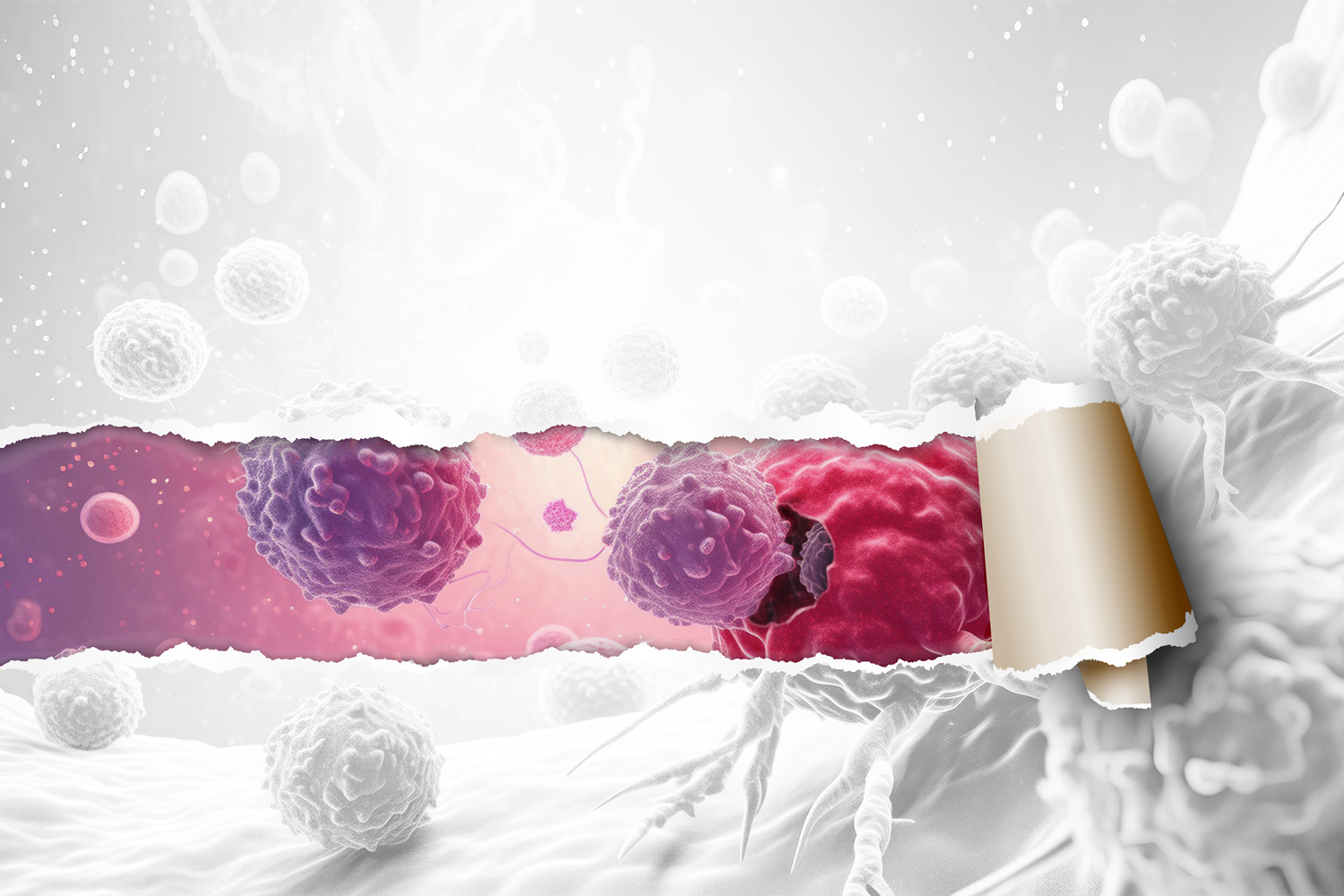IN THE SUMMER OF 2009, Mary Moulds, of Venice, Florida, showed her husband, Dave, a tiny, dark spot on her left wrist near her watch. It was rough to the touch, and she didn’t think it was a freckle. To Dave, the spot was nearly invisible, but Moulds, a retired nurse, was concerned enough to see her dermatologist. A biopsy of the spot on her skin came back positive for melanoma, and Moulds had more tissue surgically removed from the same area. The couple, both avid cyclists and world travelers, continued to enjoy their retirement, but a cyst-like bump appeared on the same arm in June 2013. Moulds got another biopsy, and again the tissue tested positive. She had stage III melanoma.
This time, Moulds went to Moffitt Cancer Center in Tampa where she had scans and surgery to remove the small tumor and the tissue around it. Subsequent scans showed signs of cancer in her right lung and in a lymph node under her arm—meaning her cancer had progressed to stage IV. The doctors at Moffitt told her about a clinical trial that would include treatment with the drug Yervoy (ipilimumab), a type of immunotherapy known as an immune checkpoint inhibitor that had been approved for melanoma in 2011. But, as part of the clinical trial, she would also receive an experimental treatment that used her own immune cells. The cells, called tumor-infiltrating lymphocytes (TILs), would be taken from her tumor tissue, grown and multiplied in a lab, and infused back into her body, her physicians told her.
Moulds liked the idea of joining a clinical trial to help not only herself but other people. The protocol would involve a grueling treatment. Moulds, who was 70 at the time, had to be cleared by a cardiologist to ensure her heart was healthy enough to withstand the procedure. She would start with two cycles of Yervoy and then receive harsh chemotherapy, including cyclophosphamide and fludarabine, to knock out her existing immune cells. If all went well, she then would get an infusion with the TILs and receive interleukin-2 (IL-2), another type of immunotherapy used to help the TILs grow and divide more quickly. IL-2 can produce flu-like symptoms, nausea, vomiting or diarrhea, and, in some cases, more serious side effects, including abnormal heartbeat, chest pain and other heart problems.
Giving the Immune System the Advantage
TIL therapy is a form of immunotherapy known as adoptive cell therapy that uses cells from a person’s own immune system to treat cancer. In adoptive cell therapy, immune cells are first isolated from a patient before they are expanded in number and then infused back into the bloodstream by the billions. TIL therapy is the first adoptive cell therapy approved to treat a solid-tumor cancer. Another type of adoptive cell therapy called CAR T-cell therapy, in which cells are removed from the bloodstream and genetically altered in a lab before being infused in patients, is approved to treat some blood cancers.
In TIL therapy, immune cells are collected from the patient’s tumor samples. The cells are then sent to a lab, where they are exposed to immune-stimulating agents and multiplied before they are infused back into the patient. The theory is that, by multiplying these immune cells and infusing them into the body, TILs will be better equipped to fight cancer, which can elude the immune system in other circumstances.
“Cancer may interfere with the ability [of immune cells] to attack and kill cancer cells,” says Amir Jazaeri, a gynecologic oncologist at the University of Texas MD Anderson Cancer Center in Houston. “By taking [immune cells] out, expanding them, and then returning them to the same patient, we’re giving the advantage to the immune system. We don’t know what these TIL cells recognize about the tumor, but there must be a reason they’ve made it in [to the tumor]. We think they are the most relevant subset of immune cells [for fighting solid cancers].”
Building the Evidence
The first evidence that TIL therapy could work dates back to 1987, when the National Cancer Institute (NCI) started a study that included 86 patients with metastatic melanoma. The trial showed that treatment with TILs and IL-2 could shrink tumors in people with advanced melanomas that hadn’t responded to treatment options available at the time. In 1994, the NCI team reported their findings in the Journal of the National Cancer Institute, showing that the overall objective response rate to TIL therapy administered with IL-2 was 34%. But, despite the early promise for the cellular immunotherapy, its development stalled behind other promising treatment options such as targeted therapies that pinpoint a mutation found in melanoma and immune checkpoint inhibitors that help the immune system fight the cancer.
In 2011, the NCI partnered with a company called Iovance Biotherapeutics in Philadelphia to continue developing TILs. More than a decade later, on Feb. 16, 2024, the Food and Drug Administration (FDA) granted accelerated approval for Iovance’s TIL therapy Amtagvi (lifileucel) for adults with metastatic melanoma or unresectable melanoma that had already been treated with immune checkpoint inhibitors or targeted therapy. The approval was based on evidence in a group of 73 people with advanced melanoma who received TIL therapy after their cancer had gotten worse despite treatment. Of the people in the trial receiving at least 7.5 billion TILs derived from their own cancer cells, 31.5% showed a response to the TIL therapy. In another analysis of 153 people, including those in the first study, the objective response rate was similar at 31.4%. In this analysis, more than half of those who responded also lived for at least a year without their cancer showing signs of growth. In addition, eight people had a complete response.
The FDA approval of Amtagvi shows that this treatment approach—which had only been available at large cancer centers through relatively small clinical trials—is not only effective but also is feasible for more widespread use, says Jazaeri. Although clinicians will need expertise and training to manage patients who receive this complex therapy, he says, the approval makes TILs accessible to more people with advanced melanoma who would otherwise be out of treatment options.
Alexander Shoushtari, a melanoma oncologist and cellular therapy specialist at Memorial Sloan Kettering Cancer Center in New York City, also is encouraged by data that suggest the treatment can have lasting effects in at least some cases. Some people who were treated with TIL therapy more than a decade ago are still alive today, Shoushtari says.
“I think we are really quite thrilled to see any durable responses,” he says. “I sum that up to people at the current moment by saying, ‘If you’re considering lifileucel [Amtagvi], it’s a lot to go through. But there’s [perhaps about] a 1 in 6 chance that we hit a home run, that it may be the last thing we need to do.’”
Not for Everybody
Amtagvi has caused excitement for its promise, but Amod Sarnaik, a surgeon and melanoma oncologist who led the clinical trial on TILs at Moffitt Cancer Center that resulted in the drug’s approval, notes the treatment can be hard on the body. Sarnaik also led the pilot trial that Moulds enrolled in back in March 2014. “Basically, what it means is that doctors who take care of patients have another weapon against cancer,” he says. “But this type of therapy is not for everybody.”
Many people with hard-to-treat advanced melanomas may not be candidates for the therapy because they have other health conditions, such as heart, lung or chronic kidney diseases. The treatment comes with a boxed warning for treatment-related mortality and other serious side effects, such as severe cytopenia (low blood cell counts), internal bleeding and infections. The therapy also requires monitoring throughout the treatment course for signs of heart, lung and kidney trouble. It must be administered in a hospital with an intensive care unit and specialists in cardiopulmonary or intensive care medicine at the ready.
Getting TIL therapy is a multistep process that takes about 10 weeks.
Tumor-infiltrating lymphocyte (TIL) therapy is a multistep process that requires surgery to remove the tumor and a lengthy hospital stay. Side effects of treatment, including flu-like symptoms, fatigue, irregular heartbeat and rash, generally end after the approximately 10 weeks of treatment and recovery. But the risks can rule out the treatment for many patients with advanced melanoma, who’ve often endured several treatments to get to the point where they are candidates for the treatment. For those considering TIL therapy or a clinical trial, here’s what to expect from the treatment:
Step 1: Tumor tissue about the size of a grape is surgically removed. A doctor chooses the site that is easiest for removing the tissue.
Step 2: Immune cells from inside the tumor tissue known as TILs are separated from the rest of the tumor sample.
Step 3: In a lab, TILs are produced in large numbers in a growth medium including interleukin-2 (IL-2) for several weeks until they number in the billions.
Step 4: Once it’s clear the cells are growing, patients receive chemotherapy in the hospital each day for seven days to clear out their own immune cells. This will make it easier for the TILs to do their work by limiting competition with other immune cells.
Step 5: The TILs are infused into the bloodstream where they can attack the tumor. The infusion takes about two hours, but patients need to stay in the hospital.
Step 6: Patients receive infusions of immune-stimulating IL-2 six times over three days to help support the TILs.
Step 7: Patients stay in the hospital for close monitoring for another few days.
Step 8: It will take several weeks for the immune system to recover. Doctors will monitor patients every three months to see if the TILs are working to shrink the cancer. When the treatment works, TILs can stay active for many years.
“We are not really confident that people at extreme ages should really go through this,” Shoushtari says, given the risks to the heart, lungs, kidney and liver. These risks stem mostly from the effects of the chemotherapy prior to TIL treatment and from IL-2 after the TIL infusion, rather than from the TILs themselves, he says. The average age of patients treated in the clinical trials that led to the approval of Amtagvi was 56, he adds, and the oldest person was 79.
On the plus side, experts note that side effects of TIL therapy often are short-lived given the treatment course lasts about two months from start to finish, compared with standard chemotherapy or other treatments that a person may need to undergo for a much longer period. Another challenge is the cost of the treatment; the price for Amtagvi is $515,000 before discounts or insurance. Other challenges include time spent at the hospital and travel to specialized centers, given the expertise needed for the procedure. Memorial Sloan Kettering requires patients to stay nearby throughout treatment in case anything goes wrong, Shoushtari says. TIL therapy requires surgery to remove the tumor and at least two weeks for chemotherapy, followed by the TIL and IL-2 infusions and monitoring in the hospital. Patients also need a friend or family member to act as a caregiver through the process.
One in 10 people will have their TILs harvested only to find that the lab was unable to grow enough TILs for them. In addition, the process of generating TILs currently takes about five weeks, which can be too long for many with metastatic melanoma to wait, Shoushtari says. He notes that some patients will never make it to his office for a consultation because they consider TIL therapy to be out of the question for them.
Aiming for More Cancers
Despite these challenges, researchers are working to improve TIL therapy in melanoma and to extend its use to other solid cancer types. Sarnaik says there are efforts underway to find ways to select and expand only those TILs that are most likely to find and fight cancer. Studies are also taking place to modify TILs so they work effectively against more cancers. And researchers are exploring ways to make the treatment less complex with fewer side effects. For example, scientists are looking at modifying TILs so the immune cells expand in number following their infusion into the bloodstream without a person needing to undergo systemic IL-2 treatment.
“I’m hoping these [improvements] will come to fruition and will carry additional approvals over the finish line,” Sarnaik says.
TIL therapy is most likely to work in cancers that, like melanoma and non-small cell lung cancer, carry many mutations that make them easier for the immune system to “see,” Sarnaik says. In addition, TIL therapy is showing promise in cancers of the cervix and the head and neck, which are malignancies that are associated with viral infections. Phase II clinical trials are currently underway for these cancers.
Trials are also looking at using TILs in combination with other types of immunotherapy, such as immune checkpoint inhibitors. Some evidence suggests that the combination of Keytruda (pembrolizumab) and TILs may double response rates in multiple solid cancers compared with using Keytruda alone. In one study, eight of 14 patients with cervical cancer who received Keytruda and TILs responded to the treatment, including one complete response and six partial responses (one had an unconfirmed partial response). At a median follow-up of 7.6 months, five of the seven patients in the trial with confirmed responses had an ongoing response. A phase III trial testing a combination of Keytruda and TIL therapy in advanced melanoma is now enrolling patients.
A study led by Jazaeri and colleagues published Feb. 2, 2024, in the Journal for ImmunoTherapy of Cancer looked at TIL therapy in cancers that haven’t generally responded well to immunotherapies, including colorectal, pancreatic and ovarian cancer. The study enrolled 16 patients with a median age of 57, but researchers noted that none of the patients’ tumors shrunk 12 weeks after receiving the treatment. However, 63% of people in the study showed signs that their tumors had stopped growing. Stable disease is still a victory, Jazaeri says, although he and his patients would prefer to see the tumors shrinking.
Moulds got the clearance she needed from the cardiologist and received her one-time infusion of TILs in June 2014. After receiving the cells, she had three rounds of IL-2 each day for five days to give her new immune cells a boost. After the fifth day of IL-2 infusions, she suddenly went into atrial fibrillation, a type of abnormal heart rhythm that causes extremely fast and irregular heartbeats, and spent the weekend in the intensive care unit. She also got a severe rash and needed multiple blood transfusions to treat anemia. The treatment caused her to lose pigment in her skin, which has never come back. Four months later, in October 2014, her first scan showed her tumors were shrinking. With each subsequent scan, they got smaller.
Moulds, now 80, doesn’t need ongoing treatment, and she and her husband have been able to check many destinations off their travel bucket list, including Rome and Istanbul. In September 2018, with her disease stable, she started getting annual scans, which haven’t shown any signs of her melanoma progressing. While Moulds’ memory of all she has gone through isn’t what it used to be following a stroke two years ago, she and her husband are grateful to know that TIL therapy is now available to more people who have melanoma and may soon be used to treat patients with other solid cancers. She’s proud of the part she played in advancing knowledge about this treatment.
“It’s not a journey for the faint of heart, but it’s been very successful in our estimation,” Moulds’ husband, Dave, says.
Cancer Today magazine is free to cancer patients, survivors and caregivers who live in the U.S. Subscribe here to receive four issues per year.





